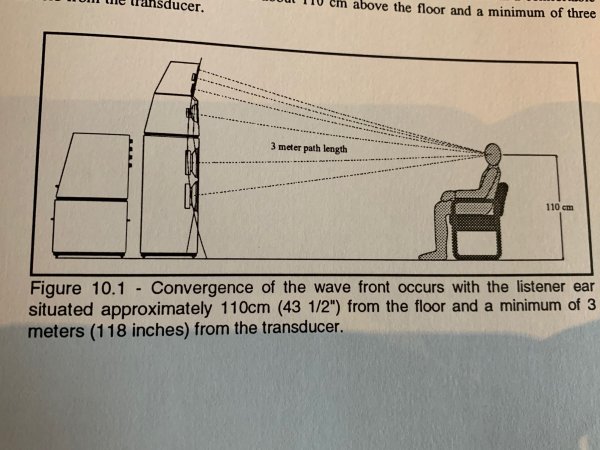Who cares how they sound....they look absolutely fantastic! Congratulations.
Avalon Osiris , my next project!
- Thread starter shakti
- Start date
You are using an out of date browser. It may not display this or other websites correctly.
You should upgrade or use an alternative browser.
You should upgrade or use an alternative browser.
I have heard the Avalon Saga at the HK hifi show that last couple of years. Just about the best sound at the show - absolutely stunning.
The Osiris speakers look stunning - I would be very surprised if they did not surpass the Maxx3's.
The Osiris speakers look stunning - I would be very surprised if they did not surpass the Maxx3's.
If my personal story with the Avalon Acoustics Osiris will continue, I will report in this thread, otherwise I hope that one or the other had fun reading something about the Avalon brand again.
Wonderful job of research and history - an enjoyable read. Thanks!
This morning I studied the theory of the Avalon Osiris line-up, the instruction manual comes as a bound book and luckily goes into the room acoustics in great detail.
I want to move the heavy parts, ie speakers and crossovers as little as possible,
so I prefer to start with the theoretically best point
A very large article is dedicated especially to the bass range, which brings the special features of the Osiris as a closed housing with deep tuning.
On my wooden floor there are still the Wilson Audio lineups
Marked "Zero Pressure Zones", within which a Wilson speaker is to be built.
Think the zones are not wrong for an Avalon to start with either.
The Avalon manual specifies that the LS should be on the short side of the room, because I don't have one,
the LS will remain on the front wall.
Important for the performance of the Osiris is a large distance from the rear wall, which should be at least 8ft / 2.4m between the rear wall and dust protection cap of the bass chassis, which I interpret as about 250cm.
Since my front wall runs at an angle, the Maxx 3 resulted in 235cm for the right channel and 300 cm for the left channel.
This is also the reason for my large central diffuser (RD-Acoustic), which compensates for this angle somewhat and thus optimizes the centering.
Accordingly, the Osiris are now about 15 cm further in the room than the Maxx3, which simplifies the placement of the two crossover elements.
The basic distance and thus the ideal side wall distance is Avalon recommended using the formula:
4: 10: 4
Since my space at the position of the loudspeaker is significantly wider than in the area of the listening position, I used the width in the area of the first side wall reflection. My room is about 670 cm wide at this point, which would correspond to a distance of the speakers (mid point speaker to mid point speaker) of 370 cm.
The Wilson Maxx 3 were about 350cm apart.
However, my two side walls are very different, ie one wall has three windows with deep window niches, the other wall is bricked smooth.
In this respect, my experience is that LS who want to be angled into the listening position play very well in my room with such a large base distance, but speakers that are set up in parallel mostly benefit from a significantly smaller base width. Avalon specifies a maximum of 3 degrees of exposure for the Osiris, and a maximum of 5 degrees for critical side walls.
In this respect, I will start with a base width of approx. 300 cm and then try to enlarge and reduce it.
My YG Anat II Reference Professional, which was also only slightly angled, had an ideal basic distance of 270cm in my room.
Avalon pretends that the listening position should not be directly on the back wall, which I think should be taken for granted. For me, the space is also determined using the Wilson Audio "Zero Pressure Zone" method and is accordingly far in the room.
The Osiris has a predetermined inclination when the mid-high element is level,
Avalon accordingly specifies the following listening distance:
The distance between a loudspeaker and the ear of the listener should be 300m for a measured ear hight of 110cm. With this distance, the speakers' chassis would add up to "one".
A few pages further on, we speak of an ideal listening distance of 400cm with the same ear height....
My measured ear height is 80cm,
at 300cm speaker base distance my distance to the respective speaker is 430cm.
From my experience adjusting the pitch of the mid-high units, I would say that my ear may be too low. At least if you assume 400cm as the ideal distance. Now I could push the sofa back a little, or change the inclination of the mid-high unit using the rear adjustable apex spikes and thus tune to the listening position.
However, these steps will only come at the very end, because the LS should have their final height, ie not on a trolley, but on spikes.
The bass units kindly have a built-in spirit level, so aligning the base units is easy. A suitable and correspondingly long wrench is also included with the Apex spikes.
So the basis and the variables are set and the back and forward shift can begin
I want to move the heavy parts, ie speakers and crossovers as little as possible,
so I prefer to start with the theoretically best point
A very large article is dedicated especially to the bass range, which brings the special features of the Osiris as a closed housing with deep tuning.
On my wooden floor there are still the Wilson Audio lineups
Marked "Zero Pressure Zones", within which a Wilson speaker is to be built.
Think the zones are not wrong for an Avalon to start with either.
The Avalon manual specifies that the LS should be on the short side of the room, because I don't have one,
the LS will remain on the front wall.
Important for the performance of the Osiris is a large distance from the rear wall, which should be at least 8ft / 2.4m between the rear wall and dust protection cap of the bass chassis, which I interpret as about 250cm.
Since my front wall runs at an angle, the Maxx 3 resulted in 235cm for the right channel and 300 cm for the left channel.
This is also the reason for my large central diffuser (RD-Acoustic), which compensates for this angle somewhat and thus optimizes the centering.
Accordingly, the Osiris are now about 15 cm further in the room than the Maxx3, which simplifies the placement of the two crossover elements.
The basic distance and thus the ideal side wall distance is Avalon recommended using the formula:
4: 10: 4
Since my space at the position of the loudspeaker is significantly wider than in the area of the listening position, I used the width in the area of the first side wall reflection. My room is about 670 cm wide at this point, which would correspond to a distance of the speakers (mid point speaker to mid point speaker) of 370 cm.
The Wilson Maxx 3 were about 350cm apart.
However, my two side walls are very different, ie one wall has three windows with deep window niches, the other wall is bricked smooth.
In this respect, my experience is that LS who want to be angled into the listening position play very well in my room with such a large base distance, but speakers that are set up in parallel mostly benefit from a significantly smaller base width. Avalon specifies a maximum of 3 degrees of exposure for the Osiris, and a maximum of 5 degrees for critical side walls.
In this respect, I will start with a base width of approx. 300 cm and then try to enlarge and reduce it.
My YG Anat II Reference Professional, which was also only slightly angled, had an ideal basic distance of 270cm in my room.
Avalon pretends that the listening position should not be directly on the back wall, which I think should be taken for granted. For me, the space is also determined using the Wilson Audio "Zero Pressure Zone" method and is accordingly far in the room.
The Osiris has a predetermined inclination when the mid-high element is level,
Avalon accordingly specifies the following listening distance:
The distance between a loudspeaker and the ear of the listener should be 300m for a measured ear hight of 110cm. With this distance, the speakers' chassis would add up to "one".
A few pages further on, we speak of an ideal listening distance of 400cm with the same ear height....
My measured ear height is 80cm,
at 300cm speaker base distance my distance to the respective speaker is 430cm.
From my experience adjusting the pitch of the mid-high units, I would say that my ear may be too low. At least if you assume 400cm as the ideal distance. Now I could push the sofa back a little, or change the inclination of the mid-high unit using the rear adjustable apex spikes and thus tune to the listening position.
However, these steps will only come at the very end, because the LS should have their final height, ie not on a trolley, but on spikes.
The bass units kindly have a built-in spirit level, so aligning the base units is easy. A suitable and correspondingly long wrench is also included with the Apex spikes.
So the basis and the variables are set and the back and forward shift can begin
Last edited:
You are so German JürgenThis morning I studied the theory of the Avalon Osiris line-up, the instruction manual comes as a bound book and luckily goes into the room acoustics in great detail.
I want to move the heavy parts, ie speakers and crossovers as little as possible,
so I prefer to start with the theoretically best point
A very large article is dedicated especially to the bass range, which brings the special features of the Osiris as a closed housing with deep tuning.
On my wooden floor there are still the Wilson Audio lineups
Marked "Zero Pressure Zones", within which a Wilson speaker is to be built.
Think the zones are not wrong for an Avalon to start with either.
The Avalon manual specifies that the LS should be on the short side of the room, because I don't have one,
the LS will remain on the front wall.
Important for the performance of the Osiris is a large distance from the rear wall, which should be at least 8ft / 2.4m between the rear wall and dust protection cap of the bass chassis, which I interpret as about 250cm.
Since my front wall runs at an angle, the Maxx 3 resulted in 235cm for the right channel and 300 cm for the left channel.
This is also the reason for my large central diffuser (RD-Acoustic), which compensates for this angle somewhat and thus optimizes the centering.
Accordingly, the Osiris are now about 15 cm further in the room than the Maxx3, which simplifies the placement of the two crossover elements.
The basic distance and thus the ideal side wall distance is Avalon recommended using the formula:
4: 10: 4
Since my space at the position of the loudspeaker is significantly wider than in the area of the listening position, I used the width in the area of the first side wall reflection. My room is about 670 cm wide at this point, which would correspond to a distance of the speakers (mid point speaker to mid point speaker) of 370 cm.
The Wilson Maxx 3 were about 350cm apart.
However, my two side walls are very different, ie one wall has three windows with deep window niches, the other wall is bricked smooth.
In this respect, my experience is that LS who want to be angled into the listening position play very well in my room with such a large base distance, but speakers that are set up in parallel mostly benefit from a significantly smaller base width. Avalon specifies a maximum of 3 degrees of exposure for the Osiris, and a maximum of 5 degrees for critical side walls.
In this respect, I will start with a base width of approx. 300 cm and then try to enlarge and reduce it.
My YG Anat II Reference Professional, which was also only slightly angled, had an ideal basic distance of 270cm in my room.
Avalon pretends that the listening position should not be directly on the back wall, which I think should be taken for granted. For me, the space is also determined using the Wilson Audio "Zero Pressure Zone" method and is accordingly far in the room.
The Osiris has a predetermined inclination when the mid-high element is level,
Avalon accordingly specifies the following listening distance:
The distance between a loudspeaker and the ear of the listener should be 300m for a measured ear hight of 110cm. With this distance, the speakers' chassis would add up to "one".
A few pages further on, we speak of an ideal listening distance of 400cm with the same ear height....
My measured ear height is 80cm,
at 300cm speaker base distance my distance to the respective speaker is 430cm.
From my experience adjusting the pitch of the mid-high units, I would say that my ear may be too low. At least if you assume 400cm as the ideal distance. Now I could push the sofa back a little, or change the inclination of the mid-high unit using the rear adjustable apex spikes and thus tune to the listening position.
However, these steps will only come at the very end, because the LS should have their final height, ie not on a trolley, but on spikes.
The bass units kindly have a built-in spirit level, so aligning the base units is easy. A suitable and correspondingly long wrench is also included with the Apex spikes.
So the basis and the variables are set and the back and forward shift can begin
not @Kindergarten, but first lessons in Physic do start in primary schoolYou are so German JürgenDo you guys have engineering class in kindergarten ? I still have recurring nightmares about the setup instructions for the MBL 101E speakers

My profession is mechanical engineering, so I am really focussed on preparing. Everything what can be done theoretically from the Sofa will be done from there, every physical move of the heavy speakers will be reduced as much as possible
The Danish version of a speaker install is : Plop the speaker down where the last one stood, and drink sufficient beer ( preferable Tuborg) while you move it around til it sounds good, or you get too drunk, whatever comes first. This might not be done safely in one daynot @Kindergarten, but first lessons in Physic do start in primary school
My profession is mechanical engineering, so I am really focussed on preparing. Everything what can be done theoretically from the Sofa will be done from there, every physical move of the heavy speakers will be reduced as much as possible
Do you sleep in your car once in a while Lagonda.The Danish version of a speaker install is : Plop the speaker down where the last one stood, and drink sufficient beer ( preferable Tuborg) while you move it around til it sounds good, or you get too drunk, whatever comes first. This might not be done safely in one day
It’s been known to happen Tang ! If you sit in the passenger seat with the key removed from the ignition, the police cannot charge you with DUIDo you sleep in your car once in a while Lagonda.
After a few hours, the first music comes out of the speaker 
The connection with the MIT EVO 850 speaker cables was more complex than expected, because the TriWiring pair is relatively short. At least when you consider the unwieldiness of the heavy aluminum boxes.
The Avalon Osiris has 5 speaker inputs, which means that you could theoretically control the speakers with 10 monoblocks.
Avalon recommends the use of 2 stereo power amplifiers in the manual, each of which can be assigned to one channel, quasi-vertical bi-amping.
I'm not there yet, so my Jeff Rowland M825 stereo power amplifier must be sufficient for the time being, maybe there will be a second one in the mid term future.
The M825 has 2 speaker outputs per channel, so that one set of triwiring and one set of biwiring cables can be connected.
I had previously considered that I would like to have the frequency ends fed by the BiWiring cable. At MIT the cable ends are labeled in Low, High, mid, etc., so that Biwiring Low is now connected to the bass crossover and Biwiring High to the super tweeter crossover.
Accordingly, the triwiring cable is divided between the mid-woofer and the other two tweeters.
In fact, the aluminum boxes facing the amplifier require a base, otherwise the cables cannot be connected.
At that time, the MIT EVO 850 cables were developed by MIT together with Neil Patel as technology support (among others) at Osiris, so I will not try any other cables for the time being.
With this MIT wiring behind the power amplifier and loudspeaker, the cable mess definitely takes on epic proportions.
Now let Osiris have an hour of music to arrive and warm up, then I'll listen to the speaker.
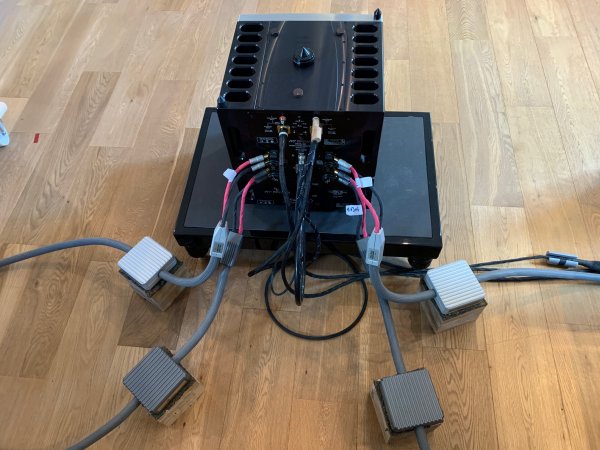
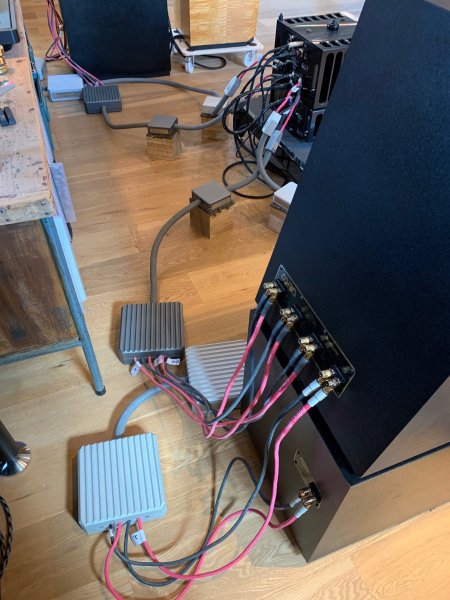
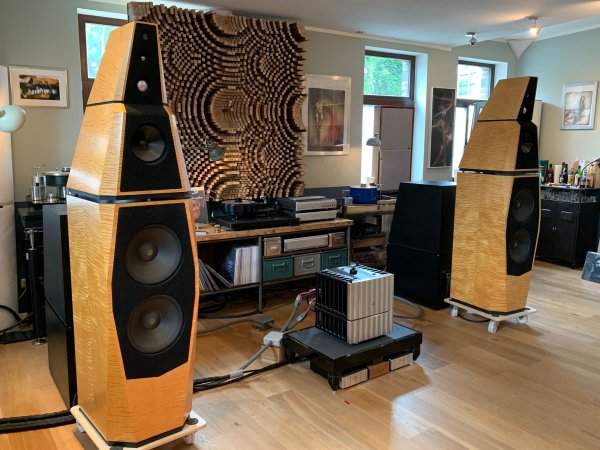
The connection with the MIT EVO 850 speaker cables was more complex than expected, because the TriWiring pair is relatively short. At least when you consider the unwieldiness of the heavy aluminum boxes.
The Avalon Osiris has 5 speaker inputs, which means that you could theoretically control the speakers with 10 monoblocks.
Avalon recommends the use of 2 stereo power amplifiers in the manual, each of which can be assigned to one channel, quasi-vertical bi-amping.
I'm not there yet, so my Jeff Rowland M825 stereo power amplifier must be sufficient for the time being, maybe there will be a second one in the mid term future.
The M825 has 2 speaker outputs per channel, so that one set of triwiring and one set of biwiring cables can be connected.
I had previously considered that I would like to have the frequency ends fed by the BiWiring cable. At MIT the cable ends are labeled in Low, High, mid, etc., so that Biwiring Low is now connected to the bass crossover and Biwiring High to the super tweeter crossover.
Accordingly, the triwiring cable is divided between the mid-woofer and the other two tweeters.
In fact, the aluminum boxes facing the amplifier require a base, otherwise the cables cannot be connected.
At that time, the MIT EVO 850 cables were developed by MIT together with Neil Patel as technology support (among others) at Osiris, so I will not try any other cables for the time being.
With this MIT wiring behind the power amplifier and loudspeaker, the cable mess definitely takes on epic proportions.
Now let Osiris have an hour of music to arrive and warm up, then I'll listen to the speaker.



WAF ? One of my wife’s said the Crescendo cables looked like garden hoses on the living room floor, i wonder what she would say about thisAfter a few hours, the first music comes out of the speaker
The connection with the MIT EVO 850 speaker cables was more complex than expected, because the TriWiring pair is relatively short. At least when you consider the unwieldiness of the heavy aluminum boxes.
The Avalon Osiris has 5 speaker inputs, which means that you could theoretically control the speakers with 10 monoblocks.
Avalon recommends the use of 2 stereo power amplifiers in the manual, each of which can be assigned to one channel, quasi-vertical bi-amping.
I'm not there yet, so my Jeff Rowland M825 stereo power amplifier must be sufficient for the time being, maybe there will be a second one in the mid term future.
The M825 has 2 speaker outputs per channel, so that one set of triwiring and one set of biwiring cables can be connected.
I had previously considered that I would like to have the frequency ends fed by the BiWiring cable. At MIT the cable ends are labeled in Low, High, mid, etc., so that Biwiring Low is now connected to the bass crossover and Biwiring High to the super tweeter crossover.
Accordingly, the triwiring cable is divided between the mid-woofer and the other two tweeters.
In fact, the aluminum boxes facing the amplifier require a base, otherwise the cables cannot be connected.
At that time, the MIT EVO 850 cables were developed by MIT together with Neil Patel as technology support (among others) at Osiris, so I will not try any other cables for the time being.
With this MIT wiring behind the power amplifier and loudspeaker, the cable mess definitely takes on epic proportions.
Now let Osiris have an hour of music to arrive and warm up, then I'll listen to the speaker.
View attachment 66675View attachment 66674View attachment 66673
WAF ? One of my wife’s said the Crescendo cables looked like garden hoses in the living room floor, i wonder what she would say about this
Fortunately the room is a dedicated music room and not our living room,
so my wife is happy, that my playground has a door, which can be closed
Now I listened to music for a few hours and kept moving the Avalon Osiris in different directions, which is very quick and easy thanks to the furniture roller. Fortunately, the cables to the crossovers are long enough so that they can stop.
At the beginning I had to be aware of my wish regarding the sound image. My ears are currently conditioned by the performance of the Maxx 3, so if I listen to adjust the Osiris music that I've heard a lot lately, I'll try to adjust the speaker to my listening standards and make the Osiris sound that way as I am used to from the Maxx 3.
Neil Patel had always given his Avalon speakers (at least the models older than 10 years) a target curve that slopes slightly in the high frequency range. Just like that many users of digital correction systems like to do
This is more evident on the Osiris than on the Maxx 3.
Here is a picture of the Osiris frequency response from Audio magazine.
In the accompanying text it was pointed out that it was difficult to measure the LS in the existing measuring room of 20sqm, especially the frequency response below 200hz probably caused problems.
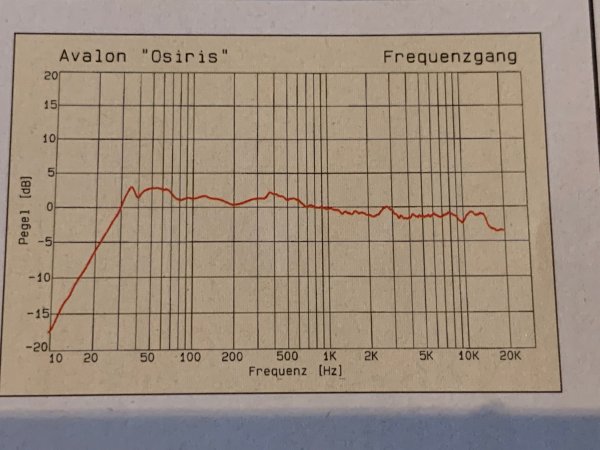
In this respect, my goal is to first grasp the character of the Avalon Osiris and choose a layout that maintains this character but at the same time optimally integrates the loudspeaker into the room.
But first of all, listen with a pure voice piece, which is what the midrange area basically says.
And the first notes are very promising, right from the start the mid-range can offer a higher resolution than I had heard of very well-known pieces to date. Everyone knows this for sure, you have a few standard pieces with which you can listen to unknown systems, pieces that you haven't heard in a while. In any case, the Osiris is able to show the choir singers individually in their position in the room, even in a position that is not yet optimal. With very well known solo voices, the Osiris is able to represent them more naturally than I have known until now.
And all of this, with a less than optimal setup.
Then I took a piece with deep bass, also here the positive astonishment that you get the impression that the Osiris can top the Maxx 3 standing freely in this area. Sure, everything is not yet optimal, as it is not yet in position and on furniture rollers, but it is very impressive to begin with.
The high-frequency resolution cannot be judged correctly from my sofa, the Osiris is just too high on the rollers for that, but when I sit behind my sofa, I sit at a greater distance and a little higher, then it fits impressively well.
So I will probably have to move the sofa a bit and also have to tilt the mid-high units a little more forward so that the high-frequency range snaps into place on my sofa.
Now pushing continues and writing continues at the break.
At the beginning I had to be aware of my wish regarding the sound image. My ears are currently conditioned by the performance of the Maxx 3, so if I listen to adjust the Osiris music that I've heard a lot lately, I'll try to adjust the speaker to my listening standards and make the Osiris sound that way as I am used to from the Maxx 3.
Neil Patel had always given his Avalon speakers (at least the models older than 10 years) a target curve that slopes slightly in the high frequency range. Just like that many users of digital correction systems like to do
This is more evident on the Osiris than on the Maxx 3.
Here is a picture of the Osiris frequency response from Audio magazine.
In the accompanying text it was pointed out that it was difficult to measure the LS in the existing measuring room of 20sqm, especially the frequency response below 200hz probably caused problems.

In this respect, my goal is to first grasp the character of the Avalon Osiris and choose a layout that maintains this character but at the same time optimally integrates the loudspeaker into the room.
But first of all, listen with a pure voice piece, which is what the midrange area basically says.
And the first notes are very promising, right from the start the mid-range can offer a higher resolution than I had heard of very well-known pieces to date. Everyone knows this for sure, you have a few standard pieces with which you can listen to unknown systems, pieces that you haven't heard in a while. In any case, the Osiris is able to show the choir singers individually in their position in the room, even in a position that is not yet optimal. With very well known solo voices, the Osiris is able to represent them more naturally than I have known until now.
And all of this, with a less than optimal setup.
Then I took a piece with deep bass, also here the positive astonishment that you get the impression that the Osiris can top the Maxx 3 standing freely in this area. Sure, everything is not yet optimal, as it is not yet in position and on furniture rollers, but it is very impressive to begin with.
The high-frequency resolution cannot be judged correctly from my sofa, the Osiris is just too high on the rollers for that, but when I sit behind my sofa, I sit at a greater distance and a little higher, then it fits impressively well.
So I will probably have to move the sofa a bit and also have to tilt the mid-high units a little more forward so that the high-frequency range snaps into place on my sofa.
Now pushing continues and writing continues at the break.
Ooh, as an osteopath, I do not like that lumbar spine posture/sitting position.
They better sound good if you're gonna wreck your low back discs and get slumped shoulders. NO LOL.
They better sound good if you're gonna wreck your low back discs and get slumped shoulders. NO LOL.
Similar threads
- Replies
- 6
- Views
- 823
- Replies
- 20
- Views
- 4K
- Replies
- 1
- Views
- 269
- Replies
- 6
- Views
- 4K
| Steve Williams Site Founder | Site Owner | Administrator | Ron Resnick Site Owner | Administrator | Julian (The Fixer) Website Build | Marketing Managersing |


